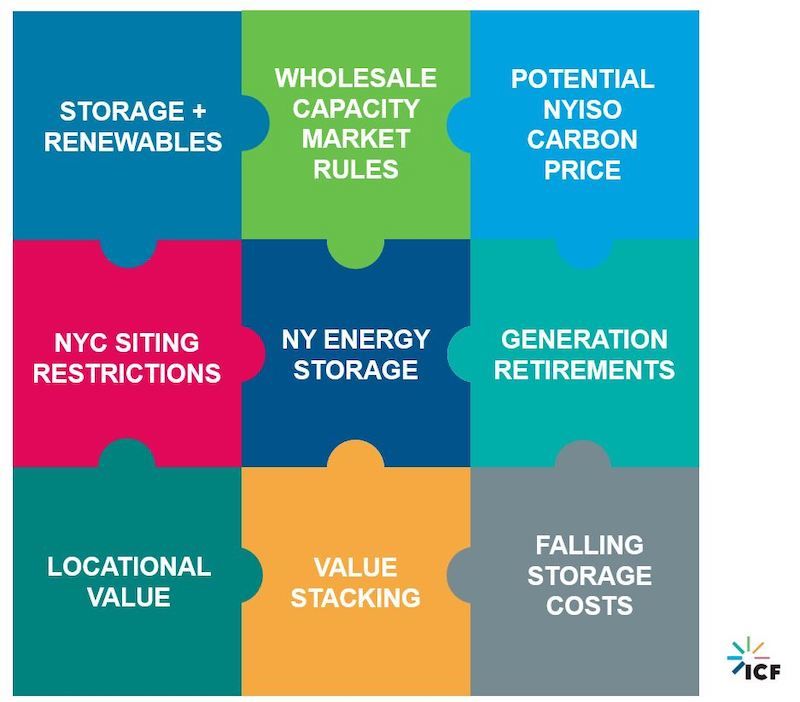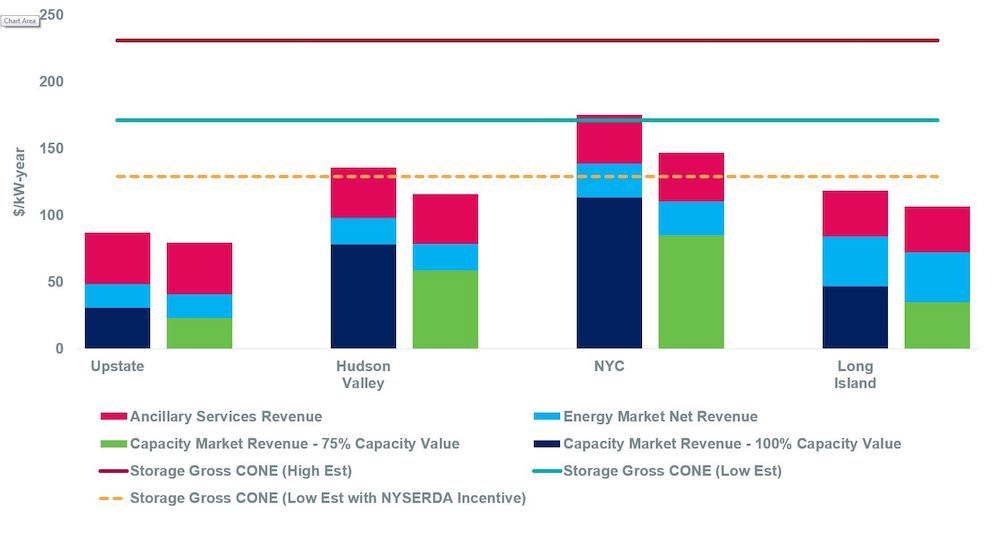
Fitting battery storage into the New York energy puzzle
Opportunities and challenges for energy storage abound in the NYISO electricity market.
Energy storage optimism is high in New York, with headlines of rapidly falling costs and New York’s Public Service Commission’s (PSC) aggressive statewide goal of 1,500 megawatts by 2025 and 3,000 megawatts deployed by 2030. The New York Independent System Operator (NYISO) is also updating its market rules to facilitate the full participation of storage in the wholesale power market. While state incentives will play a role, wholesale market revenues will strongly influence the speed and pervasiveness of storage deployment in New York and may tip the balance between competing projects.
Figure 1: Opportunities to include battery storage in the New York energy market

The economics and opportunities facing storage today
Although it is often assumed that storage revenues will come primarily from arbitrage of energy prices, capacity revenues will likely play the decisive role in NYISO. Because the capacity market ensures that more than enough generating capacity always exists to meet peak demand, energy prices in NYISO rarely spike to the extremely high levels needed to justify storage investment based on arbitrage alone.
Premium-priced ancillary services, such as regulation, provide attractive revenues but represent a small and easily-saturated market. Over time, successful achievement of New York’s ambitious renewable energy targets or adoption of NYISO’s proposed carbon pricing rule could change this dynamic by boosting energy arbitrage opportunities and ancillary services procurement.
The figure below compares the estimated cost of new entry (CONE) of a four-hour utility-scale lithium-ion battery system to modeled wholesale market revenues based on five-year average capacity prices and 2018 energy and reserve prices. CONE reflects the theoretical annual revenue required to justify investment in a new plant. This includes the annualized capital cost of batteries and other equipment, fixed operating costs, replacement of degraded batteries, and a return on investment. They do not reflect the Investment Tax Credit (ITC). The substantial incentives recently proposed by NYSERDA, which range from $75-110/kWh for bulk projects, are shown as a reduction to capital cost. Revenues reflect capacity prices under differing reserve margin credit assumptions and co-optimized participation in the day-ahead energy and ten-minute operating reserve markets.
Figure 2: Estimated NYISO storage revenues vs costs

At today’s costs and market prices, utility-scale lithium-ion storage faces challenging merchant economics in most NYISO regions but could be at or near viability if low-end cost estimates and NYSERDA bulk system incentives are assumed. The remaining economic gap is partly due to the high capital costs of storage systems, and also due to depressed capacity price levels outside of the premium New York City market. Low capacity prices are the result of excess capacity and flat demand growth in recent years and indicate that the NYISO’s target reserve margin can be more than adequately met with existing plants at present.
New developments on the horizon
Upcoming developments could create opportunities for battery storage and shift the economics, potentially quickly. First and foremost, battery costs and installed costs of grid-scale systems are continuing to decline rapidly, and it is not yet clear if and when they will bottom out. The low-price environment and a number of state regulatory measures could begin to weed out excess capacity, including the likely retirement of coal and nuclear plants in the near future and aging peaking plants down the line.
Asset retirements will create room in the market for newer, more efficient resources. NYISO capacity prices are notoriously fickle and can swing substantially with modest changes in supply and demand due to the steepness of the capacity market demand curve. Unexpected resource retirements, combined with falling costs and finalization of NYISO’s Energy Storage Resource rules, could make the economic case for storage much stronger in the next few years.
The pairing of storage with renewables is another strong near to mid-term opportunity. Although large-scale renewable development sites are less likely to be located in downstate zones where capacity value is greatest, storage assets charging from a renewable source are eligible for the federal Investment Tax Credit (ITC), which may significantly defray still-high capital costs. Developers will likely attempt to begin construction soon, as the tax credit will decline after 2019 from a high of 30 percent.
Moreover, the New York Public Service Commission has ordered an evaluation of whether the state’s ongoing renewable energy procurements should target energy storage. This could give combined renewable and storage proposals a competitive edge in securing lucrative renewable energy credit (REC) contracts. Developers will have to trade off these near-term advantages with future battery cost declines and uncertainty on the outcome of NYISO’s forthcoming resource aggregation rules.
Storming the New York City castle
The largest revenue opportunity for storage is in New York City, which has among the highest capacity prices in the U.S. and a constraint-laden transmission network with attractive locational marginal price (LMP) arbitrage opportunities at some locations. Many existing plants in NYC are well past typical retirement age or are under regulatory pressure to retire.
Proposed air quality regulations, which could affect over three gigawatts of peaking capacity in the city and Long Island, include storage as a compliance option. The Public Service Commission has called for a study of peaker replacement options in its recent order, adopting a storage deployment goal. Additionally, storage could benefit from the state’s ongoing procurement of large quantities of offshore wind, interconnecting at New York City and Long Island, due to increasing energy market volatility.
Despite these fundamental drivers, projects in New York City will need to overcome barriers to entry related to the relative scarcity of suitable sites and NYISO-enforced buyer-side mitigation measures. Under these rules, new entrants may receive a restrictive capacity market bid floor unless proven to be fully economic under strict standards. Projects relying on contracts with utilities or state subsidies may risk the loss of any capacity market revenues.
These rules are intended to deter manipulation of the market by utilities and the state. But, they may also provide effective protection to the city’s incumbent generators and encourage retention of existing plants past the point where replacement could be beneficial.
However, cracks in this system are beginning to appear. The PSC has urged NYISO to exempt energy storage from mitigation rules, and NYISO is considering whether an exemption for the repowering of existing facilities (presumably including storage) is warranted.
Capacity resource performance
Evolution of market rules towards more explicit compensation for reliability services could affect the extent to which storage challenges existing conventional plants. Several market design initiatives are presently underway, prompted by a study commissioned by the NYISO in 2017 that identified capacity performance issues and potential improvements. These initiatives include:
- a study of the resilience of New York’s heavily gas-based system during periods of extremely cold weather;
- more tailored measurement and compensation of capacity resource availability during times of system need;
- improved measurement of the performance of external capacity suppliers; and
- increased procurement of operating reserves.
There is a reason to believe that, by penalizing presently underperforming resources and rewarding responsiveness and reliability during times of system stress, new opportunities for batteries could emerge.
Enhanced scrutiny on reliability value also comes with challenges for storage resources. More pointed measurement of performance would create both opportunity for storage to shine and heightened operational risk. Moreover, while batteries have advantages in terms of speed and flexibility, their limited discharge capacity raises the question of “fractional capacity value,” or how much to credit them in the capacity market compared to a conventional plant that can run indefinitely provided it has fuel.
Recent estimates of fractional capacity value by NYISO, its independent market monitor, and the New York Battery Energy Storage Technology Consortium (NY-BEST) have notably diverged. The estimated minimum duration to achieve full capacity credit ranges from the current four-hour requirement to as high as eight hours. NYISO’s most recent proposal at the time of writing assigns 90% capacity value for four-hour systems initially, falling to 75% after 1,000 MW have been deployed. The ultimate determination of a methodology by NYISO and its stakeholders will have important implications for how storage resources are compensated, and on the optimal design and technology choice for storage projects to maximize revenue.
DERs: The next frontier
NYISO’s ongoing development of its distributed energy resources (DER) and energy storage resource participation models could further enhance the revenue potential of storage by facilitating market participation of smaller-scale resources. While utility-scale storage systems have advantages of scale in terms of cost per megawatt for a given duration, distributed systems may offer additional locational value for site-specific services.
Some distributed storage value propositions can already be monetized in New York. Opportunities include existing or pilot programs such as the state’s Value of Distributed Resources (VDER) tariff, customer demand charge reduction, utility programs that compensate for local distribution system services, and on-site backup power valued by commercial, industrial, or residential customers. Combining these revenues with NYISO market earnings could result in attractive investment opportunities.
The details and timing of DER and ESR participation rules will affect if and when behind-the-meter storage plays a major role in the NYISO market. NYISO has proposed that aggregations of resources—which could include storage, solar, and more—at least 100 kilowatts in combined size could participate in energy, capacity, and ancillary services markets depending on their capabilities.
The critical issue to be clarified is “dual participation,” or value stacking ( i.e., how participation in state and utility programs will affect eligibility and compensation of a resource in the wholesale market). NYISO and the state have both expressed intentions to clarify dual participation, but outstanding issues are surrounding how such resources will be operated and ensuring that they are compensated for each unique service separately and exclusively.
In critical downstate zones where the opportunities are likely to be greatest, NYISO intends to apply standard buyer-side mitigation measures to DERs. This move raises uncertainty on how alternative and contracted revenues will affect competitive entry tests that could block capacity market sales.
Fitting storage into the future
Although current economics are challenging at face value, declining costs and multiple market and regulatory developments—in addition to state support—could drive battery energy storage to fit more cohesively in New York’s future. Developers and investors should act now to see if potential wholesale market revenue can change the evaluation of their projects’ competitiveness and risk.
Explore more expert insights on the future of energy storage.